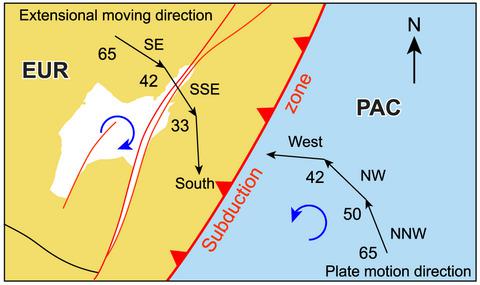当前位置:
X-MOL 学术
›
Basin Res.
›
论文详情
Our official English website, www.x-mol.net, welcomes your feedback! (Note: you will need to create a separate account there.)
Reconstruction of the Cenozoic deformation of the Bohai Bay Basin, North China
Basin Research ( IF 3.2 ) Pub Date : 2020-05-31 , DOI: 10.1111/bre.12470 Yinbing Zhu 1 , Shaofeng Liu 1 , Bo Zhang 1, 2 , Michael Gurnis 2 , Pengfei Ma 1
Basin Research ( IF 3.2 ) Pub Date : 2020-05-31 , DOI: 10.1111/bre.12470 Yinbing Zhu 1 , Shaofeng Liu 1 , Bo Zhang 1, 2 , Michael Gurnis 2 , Pengfei Ma 1
Affiliation

|
A well‐constrained plate deformation model may lead to an improved understanding of sedimentary basin formation and the connection between subduction history and over‐riding plate deformation. Building quantitative models of basin kinematics and deformation remains challenging often due to the lack of comprehensive constraints. The Bohai Bay Basin (BBB) is an important manifestation of the destruction of the North China Craton, and records the plate kinematic history of East Asia during the Cenozoic. Although a number of interpretations of the formation of the BBB have been proposed, few quantitative basin reconstruction models have been built to test and refine previous ideas. Here, we developed a quantitative deformation reconstruction of the BBB constrained with balanced cross‐sections and structural, stratigraphic, and depositional age data. Our reconstruction suggests that the basin formation process was composed of three main stages: Paleocene‐early Eocene (65‐42 Ma) extension initiation, middle Eocene‐early Oligocene (42‐32.8 Ma) extension climax, and post‐Oligocene (32.8‐0 Ma) post‐extensional subsidence. The deformation of the BBB is spatially heterogeneous, and its velocity directions rotated clockwise during the basin formation process. The reconstruction supports the interpretation that the BBB formed via strike‐slip faulting and orthogonal extension and that the basin is classified as a composite extensional‐transtensional basin. We argue that the clockwise rotation of the basin velocity field was driven by the counter‐clockwise rotation in the direction of Pacific Plate subduction. The kinematics of the BBB imply that the Pacific Plate may have been sufficiently coupled to the over‐riding East Asian Plate during the critical period of Pacific Plate reorganization. The new reconstruction provides a quantitative basis for studies of deformation processes not only in the vicinity of the BBB but more broadly throughout East Asia.
中文翻译:

华北渤海湾盆地新生代变形重建
一个受良好约束的板块变形模型可能有助于更好地理解沉积盆地的形成以及俯冲历史与上覆板块变形之间的联系。由于缺乏综合约束,建立盆地运动学和变形的定量模型仍然具有挑战性。渤海湾盆地(BBB)是华北克拉通破坏的重要体现,记录了新生代东亚板块运动史。尽管已经提出了许多关于 BBB 形成的解释,但很少建立定量盆地重建模型来测试和完善先前的想法。在这里,我们开发了一个受平衡横截面和结构、地层和沉积年龄数据约束的 BBB 的定量变形重建。我们的重建表明盆地形成过程由三个主要阶段组成:古新世-早始新世(65-42 Ma)伸展开始、中始新世-早渐新世(42-32.8 Ma)伸展高潮和后渐新世(32.8-0 Ma) 伸展后下沉。BBB的变形在空间上是不均匀的,在盆地形成过程中其速度方向顺时针旋转。重建支持了 BBB 由走滑断裂和正交伸展形成的解释,该盆地被归类为复合伸展-张张盆地。我们认为盆地速度场的顺时针旋转是由太平洋板块俯冲方向的逆时针旋转驱动的。BBB 的运动学表明,在太平洋板块重组的关键时期,太平洋板块可能已经与压倒一切的东亚板块充分耦合。新的重建不仅为 BBB 附近而且更广泛地整个东亚的变形过程研究提供了定量基础。
更新日期:2020-05-31
中文翻译:

华北渤海湾盆地新生代变形重建
一个受良好约束的板块变形模型可能有助于更好地理解沉积盆地的形成以及俯冲历史与上覆板块变形之间的联系。由于缺乏综合约束,建立盆地运动学和变形的定量模型仍然具有挑战性。渤海湾盆地(BBB)是华北克拉通破坏的重要体现,记录了新生代东亚板块运动史。尽管已经提出了许多关于 BBB 形成的解释,但很少建立定量盆地重建模型来测试和完善先前的想法。在这里,我们开发了一个受平衡横截面和结构、地层和沉积年龄数据约束的 BBB 的定量变形重建。我们的重建表明盆地形成过程由三个主要阶段组成:古新世-早始新世(65-42 Ma)伸展开始、中始新世-早渐新世(42-32.8 Ma)伸展高潮和后渐新世(32.8-0 Ma) 伸展后下沉。BBB的变形在空间上是不均匀的,在盆地形成过程中其速度方向顺时针旋转。重建支持了 BBB 由走滑断裂和正交伸展形成的解释,该盆地被归类为复合伸展-张张盆地。我们认为盆地速度场的顺时针旋转是由太平洋板块俯冲方向的逆时针旋转驱动的。BBB 的运动学表明,在太平洋板块重组的关键时期,太平洋板块可能已经与压倒一切的东亚板块充分耦合。新的重建不仅为 BBB 附近而且更广泛地整个东亚的变形过程研究提供了定量基础。


























 京公网安备 11010802027423号
京公网安备 11010802027423号